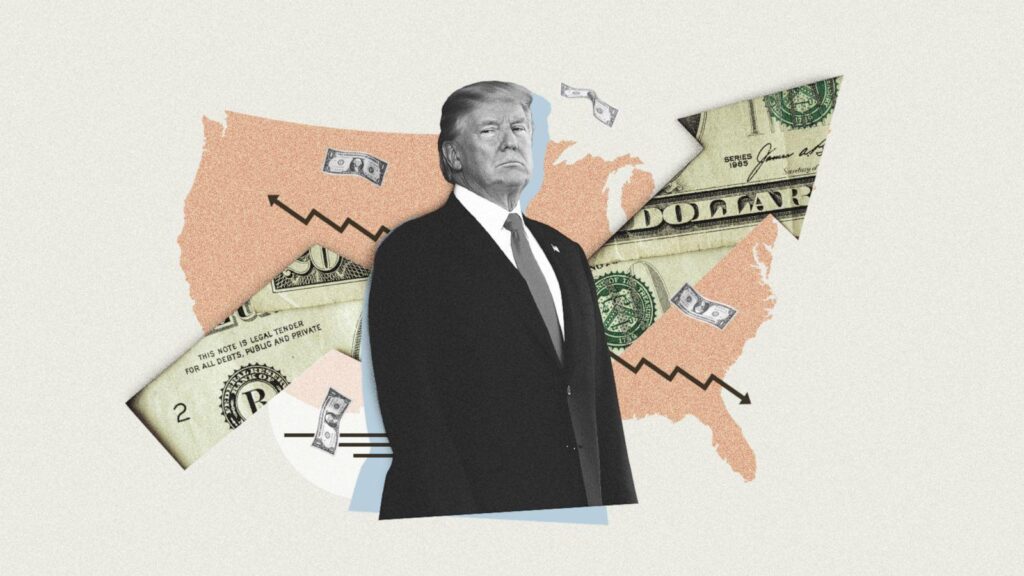As former President Donald Trump continues to rally his base under the banner of “Make America Great Again,” scrutiny of the economy during his tenure remains a contentious point. While MAGA supporters often hail his economic policies as transformative, critics argue that the economic record under Trump reveals vulnerabilities that challenge the movement’s claims of sustained prosperity. This article delves into the complexities of Trump’s economic legacy, examining key indicators and policies to assess whether the economy truly stands as a strong pillar in the MAGA narrative or represents a weak link in the broader political movement.
Trump’s Economic Policies Under Scrutiny Amid Inflation and Employment Challenges
Amid soaring inflation rates and labor market fluctuations, economists and political analysts alike are reevaluating the impact of policies enacted during the Trump administration. While proponents hail the era for tax reform and deregulation, critics argue these moves contributed to long-term economic strains that persist today. Key concerns revolve around the administration’s approach to trade wars, which disrupted supply chains and increased consumer costs, and stimulus measures that some suggest overheated an already fragile economy.
Several factors illustrate the complexity of Trump’s economic legacy:
- Inflation Trends: Inflation climbed sharply post-pandemic, influenced in part by prior fiscal policies and global disruptions.
- Employment Fluctuations: Job creation initially surged, but wage growth failed to keep pace with living costs, fueling dissatisfaction across working-class demographics.
- Trade Policies: Tariff escalations sought to protect domestic industries but led to retaliatory tariffs and higher prices.
| Policy Area | Short-Term Effect | Long-Term Impact |
|---|---|---|
| Tax Cuts | Stimulated economic growth | Contributed to budget deficits |
| Trade Tariffs | Protected select industries | Increased consumer prices |
| Deregulation | Boosted corporate profits | Raised environmental and labor concerns |
Analyzing the Impact of Trade Wars and Tax Cuts on Long-Term Growth Prospects
The policies enacted during the Trump administration, particularly the aggressive trade wars and substantial tax cuts, have produced a complex ripple effect on the United States’ economic trajectory. While the tax cuts initially sparked a surge in consumer spending and business investment, their long-term benefits are increasingly questioned. The trade tensions, marked by tariffs on key imports and retaliatory measures by trading partners, disrupted global supply chains and introduced volatility in several industries. Analysts emphasize that these protectionist measures, although aimed at safeguarding domestic jobs, may have inadvertently hindered economic competitiveness and innovation.
Key consequences to consider:
- Short-term GDP growth stimulated by increased corporate profits
- Elevated costs for manufacturers and consumers due to tariffs
- Uncertainty dampening long-run business investment strategies
- Fiscal deficits ballooning as tax revenues failed to offset cuts
| Economic Indicator | Pre-Trump Era | Post-Tax Cuts & Trade War |
|---|---|---|
| GDP Growth Rate (Annual %) | 2.3% | 2.1% |
| Federal Deficit (% of GDP) | 3.4% | 4.7% |
| Business Investment Growth | +3.1% | +1.2% |
| Import Tariff Average | 1.6% | 3.4% |
Recommendations for Strengthening Economic Foundations and Restoring Voter Confidence
To rebuild a resilient economic framework, it is essential to prioritize diversified growth strategies over singular reliance on stock market surges or short-term tax cuts. Policymakers should focus on enhancing workforce skills through targeted education and vocational programs, alongside incentivizing innovation in emerging industries. A transparent regulatory environment that balances business competitiveness with consumer protections will also reinforce economic stability. Implementing these measures can foster sustainable jobs and address underlying disparities that have eroded trust in economic leadership.
Restoring voter confidence demands a concerted effort to increase accountability and clarity in economic communication. This includes regular, honest reporting on economic challenges and progress, avoiding partisan spin. Public engagement initiatives that empower communities to have a say in economic policy formulation can bridge the gap between government actions and voter expectations. Below is an outline of actionable steps that can serve as a blueprint for rebuilding both economic foundations and democratic trust:
- Invest in infrastructure with an emphasis on green technology and job creation
- Strengthen small business support through accessible credit and resources
- Enhance transparency in government contracts and spending
- Promote bipartisan economic oversight committees to monitor progress
- Launch nationwide forums for citizen feedback on economic plans
| Recommendation | Expected Impact | Time Frame |
|---|---|---|
| Workforce Skill Development | Higher employment rates | 1-3 years |
| Infrastructure Investment | Economic stimulus and job creation | 2-5 years |
| Transparent Reporting | Increased public trust | Immediate and ongoing |
Final Thoughts
As the 2024 election approaches, the performance of the economy under Donald Trump’s leadership remains a critical point of scrutiny. While MAGA supporters rally behind his broader political agenda, economic indicators reveal persistent vulnerabilities that challenge the narrative of robust growth and prosperity. Analysts suggest that addressing these weaknesses will be essential for the movement to sustain its momentum and appeal to a wider constituency in the months ahead. The unfolding economic story will undoubtedly play a pivotal role in shaping the political landscape and voters’ decisions.
